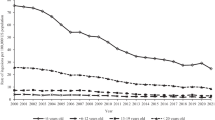Abstract
Butane hash oil (BHO), also known as “amber,” “dab,” “glass,” “honey,” “shatter,” or “wax,” is a potent marijuana concentrate, containing up to 90 % tetrahydrocannabinol (THC). BHO is easily manufactured using highly volatile butane as a solvent. Our objective was to characterize hydrocarbon burns associated with BHO manufacture in Colorado. This was a cross-sectional study utilizing the National Burn Repository to capture all hydrocarbon burns reported to the local burn center from January 1st, 2008, through August 31st, 2014. We abstracted demographic and clinical variables from medical records for patients admitted for hydrocarbon burns associated with butane hash oil extraction. Twenty-nine cases of BHO burns were admitted to the local burn center during the study period. Zero cases presented prior to medical liberalization, 19 (61.3 %) during medical liberalization (Oct 2009–Dec 2013), and 12 (38.7 %) in 2014 since legalization. The majority of cases were Caucasian (72.4 %) males (89.7 %). Median age was 26 (range 15–58). The median total-body-surface-area (TBSA) burn size was 10 % (TBSA range 1–90 %). Median length of hospital admission was 10 days. Six required intubation for airway protection (21 %). Nineteen required skin grafting, eight wound care only, one required surgical fracture repair, and one required surgical debridement. Hydrocarbon burns associated with hash oil production have increased since the liberalization of marijuana policy in Colorado. A combination of public health messaging, standardization of manufacturing processes, and worker safety regulations are needed to decrease the risks associated with BHO production.


Similar content being viewed by others
References
Colorado Constitution, Amendment 20. In: DOJ, editor. Denver, CO; 2000.
Colorado Constitution, Amendment 64. In: DOJ, editor. Denver, CO; 2012.
Monte AA, Zane RD, Heard KJ. The implications of marijuana legalization in Colorado. JAMA. 2015;313(3):241–2.
Loflin M, Earleywine M. A new method of cannabis ingestion: the dangers of dabs? Addict Behav. 2014;39(10):1430–3.
Jensen G, Bertelotti R, Greenhalgh D, Palmieri T, Maguina P. Honey oil burns: a growing problem. J Burn Care Res. 2015;36(2):e34–7.
Soriano C. Dabs 2.0: CO2 extraction for cannabis concentrates. High Times. 2014 Mar 25, 2014. http://www.hightimes.com/read/dabs-20-co2-extraction-cannabis-concentrates
Acknowledgments
Dr. Monte sits on the Retail Marijuana Public Health Advisory Committee for the State of Colorado.
Sources of funding for the project
This work was supported in part by the National Institutes of Health Grants K23 GM110516 and UL1 TR000154 (AAM).
Author information
Authors and Affiliations
Corresponding author
Rights and permissions
About this article
Cite this article
Bell, C., Slim, J., Flaten, H.K. et al. Butane Hash Oil Burns Associated with Marijuana Liberalization in Colorado. J. Med. Toxicol. 11, 422–425 (2015). https://doi.org/10.1007/s13181-015-0501-0
Published:
Issue Date:
DOI: https://doi.org/10.1007/s13181-015-0501-0




